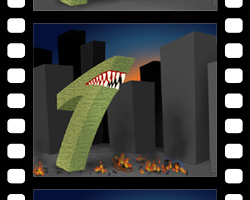Maths in the movies

Over the years there have been many portrayals of archaeologists, astronauts, lawyers and doctors on film, but there have been few mathematicians among the celluloid heroes. Recently, though, mathematicians have started to appear as characters on film and stage, taking their place amongst the Indiana Joneses of the movie world. Now another is to be added to their number.
Russell Crowe, who won an Oscar for best actor in the film "Gladiator", plays the mathematician John Nash in his next film A Beautiful Mind, for which filming is now under way. Nash made significant contributions to game theory in the 1950s which became the basis for much of modern economics. (See Game Theory and the Cuban Missile Crisis in Issue 13 of Plus.) He was awarded a Nobel prize for his work 45 years later, after having spent many years coping with schizophrenia.
Not all the recent film-mathematicians have been based on real ones. The 1997 film Good Will Hunting, written by Matt Damon and Ben Affleck and starring Robin Williams, is about a young man who has led a troubled life but has an amazing talent for mathematics. His abilities are discovered when he is in trouble with the police, and he soon has to decide whether to pursue his mathematical future and leave his family and friends behind.
In the independent film Pi made in 1998, the main character is a mathematician obsessed with his search for patterns within the infinite decimal places of pi. He believes they can be used to predict chaotic behaviours, including that of the stock market. Throughout the film he is pursued by ruthless stock market players and by rabbis trying to find a mathematical way to communicate with God.
Some of these films don't do much to dispel the stereotype of mathematicians as tortured loners, but elsewhere they are being written as action adventure and science fiction heroes. Jeff Goldblum played a mathematician who battled the Tyrannosaurus Rex and Velociraptors in both Jurassic Park films. In the science fiction film Cube (1997), where six people awake to find themselves trapped in a deadly maze, one of the characters uses mathematical skills to solve the puzzle and find a way to escape.
Mathematics is also finding its way onto the stage. The musical Fermat's Last Tango, a fictionalised account of Andrew Wiles's struggle to prove Fermat's Last Theorem, was performed in New York earlier this year by the York Theatre company. It followed the Pulitzer prize winning play "Proof" by David Aubern about the death of a brilliant mathematician and the repercussions for his daughters and his student.